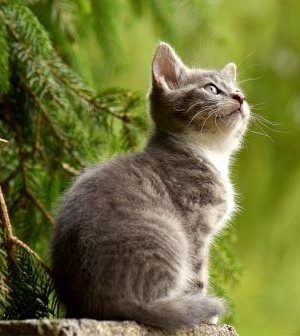- Do you subscribe to Dharma Dog Training’s Newsletter? You should.
- A Unique Campaign from The Humane Society of the United States
- Rabid bats in Omaha- Stay safe, prepared with these tips
- Springtime Activities in Omaha
- Mill Dog Monthly from Bailing Out Benji
- World Spay Day, Legislative Alert in Nebraska
- Attend the Nebraska Rescue Council’s monthly meeting this Saturday
- Five Hard-to-Ignore Reasons to Adopt!
- Paws in Pink to Benefit Breast Cancer Foundation
- VCA, Inc. Acquires MidWest Vet Specialists from Kansas State University
Explained: Is Wet or Dry Food Better for Cats?

The Big Debate: Is wet or dry food better for cats? Cats can get about four ounces of water from eating one can of food. But why else should you invest in cans?
Keyword(s): is wet or dry food better for cats
Anchor Text: cat water fountain
According to the 2019-2020 National Pet Ownership survey, approximately 42 million US households have feline family members!
Tons of questions about cat ownership circulate within the cat-loving community. Should cats be allowed outdoors? Are they social creatures or do they prefer solitude?
We’re going to talk about a question that’s on every cat owner’s mind, one that must be considered from the angles of both health and preference.
Is wet or dry food better for cats? Read on to find out everything you need to know to make an informed decision.
What Should Cat Food Contain?
In the wild, cats would eat a moisture-rich diet of meat. Unlike dogs, humans, and many other animals, cats are obligate carnivores. What that means is that their bodies are less capable of converting non-meat proteins into the protein they need to function.
Whether you’re feeding your cat dry or wet food, the first ingredient should be muscle meat. This could come from fish, poultry, or even beef, but it should be front and center. Muscle meat is the primary source of taurine which contains an amino acid that cats need to maintain their health.
Oftentimes, wet food wins when it comes to muscle meat content. However, be aware that high-quality dry food is going to be healthier than low-quality wet food.
What Shouldn’t Cat Food Contain?
Cats are able to process many veggies and grains, but these aren’t crucial to a cat’s diet. In fact, carbohydrate-rich veggies and grains can actually lead to digestive problems as well as obesity in cats.
Lower quality cat food, especially lower quality dry cat food, often contains a carb-heavy filler that you don’t want your cat consuming in large quantities. Cat food manufacturers use fillers to shape dry food into pellets and to reduce their production costs. These fillers, in other words, are cheap.
Many vets will also warn about the dangers of meat byproducts. Realistically, some meat byproducts, such as organ meats like livers, spleens, and stomach are rich in nutrients and can enrich your cat’s diet. The issue, however, is that the list of ingredients on cat food often fail to specify what those byproducts are.
A good rule of thumb is to avoid any cat food that lists a meat byproduct as the first ingredient.
Dry Food vs. Wet Food: Hydration
Perhaps one of the biggest pros of wet food is the hydration factor since it has a higher water content than dry food. Cats need to consume a lot of moisture and, as we mentioned earlier, this is something they’d get naturally from their food source in the wild.
If your cat doesn’t drink enough water from her bowl, you may need to give her wet food once a day to ensure that she’s hydrated. However, you may also want to consider her source of water. Cats, by nature, are averse to stagnant water and you may want to invest in a cat water fountain to attract her attention and convince her to drink more.
Dry Food vs. Wet Food: Dental Health
There’s an ongoing debate surrounding the dental benefits of both dry and wet food.
Some argue that dry food helps to prevent gingivitis and plaque buildup. The argument is that dry food leaves behind less residue than wet food, keeping your cat’s teeth cleaner from the get-go. Some even claim that dry food will scrape the plaque off of your cat’s teeth as they chew.
However, you may want to observe the way your cat eats when you feed her dry food. Cats’ teeth are designed for gripping prey and shredding food more than they are for chewing. When your cat eats dry food, she’s probably swallowing a lot of pieces whole rather than chewing them up individually.
This may seem to reinforce the argument that dry food leaves behind less residue, but that isn’t necessarily true. Dry pieces of kibble are designed to break into tiny pieces under slight pressure. Any pieces she is cracking into are quickly pulverized and those tiny pieces can easily get caught around the gumline.
In other words, there’s not much evidence that either kind is better for your cat’s dental health. They’ll need occasional dental cleanings no matter what they eat. The only time you might argue one over the other is if your cat has weak or missing teeth, in which case wet food may be easier on the mouth.
Dry Food vs. Wet Food: Weight Watching
If your cat is in a position to lose weight, you may want to consider switching to a regimented diet of mostly wet food.
Because of its high water content, wet food tends to help your cat feel full without eating as much. (That means she’ll be less likely to pester you mere hours after eating her last meal!) Plus, wet food contains fewer of the carb-heavy fillers that can contribute to weight gain.
Wet food also requires more active participation in feeding time on your part. Many people practice a passive feeding schedule, keeping a bowl full of dry food available throughout the day. Wet food gets a little funky after sitting out for a while which means you’ll need to pay more attention and, as a result, monitor the amount your cat is eating.
However, if your cat is in a position to gain weight, dry food may not be such a bad idea. Leaving food out 24/7 will increase the chances that your cat will wander over for a bite when she’s hungry and not just when you tell her to. Consider offering a mixed diet of both dry and wet food, since some cats actually prefer the flavor and texture of one over the other.
So, Is Wet or Dry Food Better for Cats?
You may still be wondering, “Is wet or dry food better for cats?”
The answer will come down to your cat’s specific needs. Wet food does have a lot of undeniable benefits that dry food can’t quite match. That doesn’t mean that dry food is bad for your cat and in the end, quality is what matters most!
For more useful information about all things pet-related, bookmark our website!
Latest News
-
3 Tips for Pet Owners on Training Rescue Dogs
Owning a rescue dog can take some work compared to...
- Posted 2 weeks ago
- 0
-
Choosing the Right Pet for Your Lifestyle
Are you thinking about getting a pet but unsure what...
- Posted 4 weeks ago
- 0
-
How to Make Your Rescue Pet as Comfortable as Possible
Did you bring home a new pet from a shelter...
- Posted 2 months ago
- 0
-
How Having A Pet Can Change Your Life
Having a pet can open your heart in ways that...
- Posted 7 months ago
- 0
-
How To Improve The Life Of Your Senior Pet
Do you have an elderly fur baby and want to...
- Posted 7 months ago
- 0
-
Springtime Activities To Enjoy With Your Furry Friends
Are you preparing for warmer weather and want some ideas...
- Posted 8 months ago
- 0
-
Pros And Cons Of Microchipping Your Pets
Have you considered whether your pets should be microchipped and...
- Posted 9 months ago
- 0


















You must be logged in to post a comment Login